c7641a30be4af2cd7a6f0115b15f619b.ppt
- Количество слайдов: 150

Guidelines for Preventing the Transmission of M. tuberculosis in Health-Care Settings, 2005 Division of Tuberculosis Elimination September 2006

Purpose of 2005 Guidelines • Update and replace 1994 Mycobacterium tuberculosis infection control (IC) guidelines • Further reduce threat to health-care workers (HCWs) • Expand guidelines to nontraditional settings • Simplify procedures for assessing risk • Promote vigilance and expertise needed to avert another TB resurgence

What’s New (1) • Change of risk classification and tuberculin skin test (TST) frequency • Expanded scope addressing lab, outpatient, and nontraditional settings • Expanded definitions of affected HCWs • “TST” instead of “PPD”

What’s New (2) • Quanti. FERON-TB Gold test (QFT-G) • QFT-G is a type of blood assay for M. tuberculosis (BAMT) – Measures the patient’s immune system reaction to M. tuberculosis – Blood samples must be processed within 12 hours – Interpretation of QFT-G results is influenced by the patient’s risk for infection with M. tuberculosis – An alternative to TST

What’s New (3) • Term “airborne infection isolation” (AII) • Criteria for initiating and discontinuing AII precautions • Respirator fit testing and training; voluntary use of respirators by visitors • Additional information on ultraviolet germicidal irradiation (UVGI) • Frequently asked questions (FAQs)

Change in Risk Classifications Previous New • Minimal • Low • Very low • Medium • Low • Potential ongoing transmission • Intermediate • High

HCWs Who May Be Included in a TB Testing Program • Paid and unpaid persons working in healthcare settings who have potential for exposure to M. tuberculosis through shared air space with infectious patient • Includes part-time, full-time, temporary, and contract staff • All HCWs whose duties involve face-to-face contact with suspected or confirmed TB should be in a TB screening program

Transmission of M. tuberculosis • Spread by airborne route; droplet nuclei • Transmission affected by – Infectiousness of patient – Environmental conditions – Duration of exposure • Most exposed persons do not become infected

TB Pathogenesis (1) Latent TB Infection • Once inhaled, bacteria travel to lung alveoli and establish infection • 2– 12 wks after infection, immune response limits activity; infection is detectable • Some bacteria survive and remain dormant but viable for years (latent TB infection, or LTBI)

TB Pathogenesis (2) Latent TB Infection • Persons with LTBI are – Asymptomatic – Not infectious • LTBI formerly diagnosed only with TST • Now QFT-G can be used

TB Pathogenesis (3) Active TB Disease LTBI progresses to TB disease in • Small number of persons soon after infection • 5%– 10% of persons with untreated LTBI sometime during lifetime • About 10% of persons with HIV and untreated LTBI per year

Persons at Higher Risk for Exposure to and Infection with M. tuberculosis (1) • Close contacts • Foreign-born persons from or areas with high TB incidence • Residents and staff of high-risk congregate settings • Health-care workers who serve high-risk clients

Persons at Higher Risk for Exposure to and Infection with M. tuberculosis (2) • HCWs unknowingly exposed to TB patient • Low-income, medically underserved groups • Locally defined high-risk groups • Young persons exposed to high-risk adults

Persons at High Risk for LTBI Progressing to TB Disease • Persons coinfected with HIV and M. tuberculosis (highest risk) • Those with recent M. tuberculosis infection (within 2 years) • Children under 4 years of age • Persons with certain clinical conditions or other conditions of compromised immunity • Those with a history of untreated or poorly treated TB

TB Patient Characteristics That Increase Risk for Infectiousness (1) • Coughing • Undergoing cough-inducing or aerosolgenerating procedure • Failing to cover cough • Having cavitation on chest radiograph

TB Patient Characteristics That Increase Risk for Infectiousness (2) • Positive acid-fast bacilli (AFB) sputum smear result • Disease of respiratory tract and larynx • Disease of respiratory tract and lung or pleura • Inadequate TB treatment

Environmental Factors That Increase Risk for Transmission • Exposure in small, enclosed spaces • Inadequate ventilation • Recirculating air containing infectious droplets • Inadequate cleaning and disinfection of equipment • Improper specimen-handling procedures

Risk for Health-care–Associated Transmission of M. tuberculosis (1) Risk varies by • TB prevalence in health-care setting • TB prevalence in community • Patient population served • Health-care worker occupational group • Effectiveness of infection control measures

Risk for Health-care–Associated Transmission of M. tuberculosis (2) Linked to close contact with infectious TB patients during procedures generating aerosols • Bronchoscopy • Endotracheal intubation or suctioning • Open abscess irrigation • Autopsy • Sputum induction • Aerosol treatments

Previous Health-care–Associated Transmission of M. tuberculosis (1) In hospital TB outbreaks, 1980 s– 1990 s • MDR TB spread to patients and HCWs • Many patients, some HIV-infected HCWs • Rapid progression from new infection to disease • Factors – Delayed diagnosis – Lapses in AII precautions – Lapses in respiratory protection

Previous Health-care–Associated Transmission of M. tuberculosis (2) Follow-up • Transmission much decreased or ceased in a setting when recommended infection control interventions implemented • However, effectiveness of each intervention could not be determined

Fundamentals of Infection Control (1) Hierarchy of Infection Control Administrative Controls Environmental Controls Respiratory Protection

Fundamentals of Infection Control (2) Hierarchy of Infection Control • Administrative controls: reduce risk of exposure via effective IC program • Environmental controls: prevent spread and reduce concentration of droplet nuclei • Respiratory protection controls: further reduce risk of exposure in special areas and circumstances

Administrative Controls (1) Most Important • Assign responsibility for TB infection control (IC) • Work with health department to conduct TB risk assessment and develop written TB IC plan, including AII precautions • Ensure timely lab processing and reporting • Implement effective work practices for managing TB patients

Administrative Controls (2) • Test and evaluate HCWs at risk for TB or for exposure to M. tuberculosis • Train HCWs about TB infection control • Ensure proper cleaning of equipment • Use appropriate signage advising cough etiquette and respiratory hygiene

Environmental Controls • Control source of infection • Dilute and remove contaminated air • Control airflow (clean air to lessclean air)

Respiratory Protection (RP) Controls • Implement RP program • Train HCWs in RP • Train patients in respiratory hygiene

Relevance to Biologic Terrorism Preparedness • Multidrug-resistant M. tuberculosis is classified as a category C agent of biologic terrorism • Implementing guidelines in this document is essential to preventing the transmission of M. tuberculosis in health-care settings

Recommendations for Preventing M. tuberculosis Transmission in Health-Care Settings

Develop an Infection Control (IC) Program • Perform TB risk assessments in all settings • Develop TB IC program as part of overall IC program • Base IC program on risk assessment • Determine details of IC program by likelihood that persons with TB will be encountered in that setting or transferred to another setting

Infection Control Program (1) Settings Expecting to Encounter TB Patients • Assign and train TB IC program manager • Collaborate with local health department to develop administrative controls, including – Risk assessment – Written TB IC plan, including protocols for identifying, evaluating, managing infectious TB patients – Testing and evaluation of HCWs – Training and education of HCWs – Problem evaluation and contact investigation – Coordination of discharge

Infection Control Program (2) Settings Expecting to Encounter TB Patients • Develop plan for accepting TB patients or suspects transferred from another setting • Implement and maintain environmental controls, including AII rooms • Implement RP program • Provide ongoing training and education of HCWs

Infection Control Program (3) Settings Not Expecting to Encounter TB Patients • Assign responsibility for TB IC program • Collaborate with local health department to develop administrative controls, including – Risk assessment – Written TB IC plan that outlines protocol for triage and transfer of TB patients to another health-care setting – Problem evaluation and contact investigation

TB Risk Assessment (1) Settings Expecting to Encounter TB Patients • Collaborate with health department to review community TB profile, obtain epidemiologic data for risk assessment • Review number of TB patients encountered • Determine – HCWs to be included in TB testing and in RP program – Instances of unrecognized TB – Number of AII rooms needed – Types of environmental controls needed

TB Risk Assessment (2) Settings Expecting to Encounter TB Patients • Identify and address areas with increased transmission risk • Ensure prompt recognition and evaluation of M. tuberculosis transmission in setting • Conduct periodic reassessments • Correct lapses in IC

TB Risk Assessment (3) Settings Not Expecting to Encounter TB Patients • Collaborate with health department to review community TB profile; obtain epidemiologic data for risk assessment • Determine – If any HCWs need to be included in TB screening program – If unrecognized TB occurred in last 5 years – Types of controls in place, types needed

TB Risk Assessment (4) Settings Not Expecting to Encounter TB Patients • Document steps for prompt recognition and evaluation of suspected M. tuberculosis transmission • Conduct periodic reassessments • Correct any lapses in IC

TB Risk Classifications (1) All settings should perform risk classification as part of risk assessment to determine need for and frequency of an HCW testing program, regardless of likelihood of encountering persons with TB disease.

TB Risk Classifications (2) • Low risk – Persons with TB disease not expected to be encountered; exposure unlikely • Medium risk – HCWs will or might be exposed to persons with TB disease • Potential ongoing transmission – Temporary classification for any settings with evidence of person-to-person transmission of M. tuberculosis

TB Risk Classifications (3) Inpatient Settings Low Medium <200 beds <3 TB patients/yr >3 TB patients/yr <6 TB patients/yr >6 TB patients/yr ≥ 200 beds Potential Ongoing Transmission Evidence of ongoing transmission, regardless of setting

TB Risk Classifications (4) Outpatient Settings TB treatment facilities, medical offices, ambulatory care settings Low <3 TB patients/yr Medium Potential Ongoing Transmission >3 TB patients/yr Evidence of ongoing transmission, regardless of setting

TB Risk Classifications (5) Nontraditional Facility-based Settings Emergency medical service (EMS), medical settings in correctional facilities, outreach care, long-term care facilities Low Medium Only patients with LTBI treated Settings where TB patients are expected to be encountered No coughinducing procedures are performed in setting System to detect/triage persons with TB symptoms Potential Ongoing Transmission Evidence of ongoing transmission regardless of setting

TB Risk Classification Example Small Hospital • 150 -bed hospital in small city • 2 TB patients admitted in past year – 1 placed directly in AII room – 1 stayed on medical ward 2 days before AII placement • Contact investigation showed no evidence of transmission Risk classification: Low

Risk Classification Example Public Health Clinic • Ambulatory-care setting where TB clinic is held 2 days/week • In past year, 6 TB patients and 50 LTBI patients treated • No evidence of transmission Risk classification: Medium

Risk Classification Example Public Hospital • Large public hospital in big city – Average of 150 TB patients/year (35% of city burden) – Strong IC program; many AII rooms – Annual TST conversion rate among HCWs of 0. 5% • Hospital has strong links with health department • No evidence of transmission Risk classification: Medium, with close ongoing surveillance for episodes of transmission

Risk Classification Example Prison Setting • Inpatient area of a correctional facility • Some inmates are from TB-prevalent countries • In past year, 2 cases of TB diagnosed in inmates Risk classification: Medium

Risk Classification Example Large Hospital • Big-city hospital with 35 TB patients/year • TST conversion rate among HCWs of 1. 0% • At annual testing, 3/20 (15%) respiratory therapists (RTs) had TST conversions • Problem evaluation – The 3 RTs who converted spent time in lab where induced sputum specimens were collected, and lab venting was inadequate Risk classification: 1. Potential ongoing transmission for the RTs 2. Medium risk for the rest of the setting

Risk Classification Example Health Maintenance Organization (HMO) Clinic • Ambulatory-care center associated with a large HMO where TB rates are highest in the state • In past year, 1 TB patient presented • At first visit patient was – Recognized as having TB – Sent to an emergency department with an AII room – Held separately and asked to wear a mask before triage • Contact investigation showed no evidence of transmission Risk classification: Low

Risk Classification Example HIV-Care Clinic • Hospital-affiliated HIV clinic serving 2, 000 patients • Has AII room and a TB IC program • All patients screened for TB at enrollment – Those with respiratory complaints placed in AII • In past year, 7 patients found to have TB – All 7 promptly put in an AII room – No contact investigation done – Annual conversion rate of 0. 3% (same as rate in hosp) Risk classification: Medium (because of HIV-infected persons)

Risk Classification Example Home Care Agency • Home health-care agency serving a poor area with TB rates higher than overall community • Has 125 employees – About 30% of workers are foreign-born (FB), many immigrated within past 5 years – Provide nursing, physical therapy, basic home care – On baseline 2 -step testing, 4 had (+) initial result; 2 had (+) second result (3 of 4 are FB); no TB disease. • In past year, agency had no TB patients Risk classification: Low. Could be medium if FB workers are from TB-prevalent countries, or large number of clients are HIV infected.

TB Testing Frequency Risk classification Frequency Low Baseline on hire; further testing not needed unless exposure occurs Medium Baseline, then annually Potential ongoing transmission Baseline, then every 8– 10 wks until evidence of transmission has ceased

Testing HCWs Who Transfer • All HCWs should receive baseline TB testing • In IC plans, address HCWs who transfer to another setting • Keep all historic testing results; in future, might need to interpret results of TST vs. QFT-G

TB Testing Frequency for HCWs Who Transfer Situation Risk Classification Change Low or Med → Potential Low→Low Low→Med Ongoing Transmission Yes Yes No Every 12 As needed in months investigation Baseline Routine testing Yes, and if TST negative, 8– 10 wks after last After exposure potential exposure to M. tuberculosis

Evaluating TB IC Procedures and Identifying Problems (1) • Annually evaluate TB IC plan • Review medical records of a sample of patients with suspected or confirmed TB disease to find possible problems in TB IC • Use data from risk assessment worksheet in conducting review

Evaluating TB IC Procedures and Identifying Problems (2) Factors to consider in TB IC evaluation • Time intervals for all related activities • Duration of AII precautions • Extent of meeting criteria for discontinuing AII precautions • Patient history of previous admissions • Adequacy of TB treatment regimens • Adequacy of sputum collection procedures • Adequacy of discharge planning • Number of visits to outpatient setting

Evaluating Environmental Controls (1) • Determine if recommended environmental controls are in place by reviewing recent environmental evaluation • Review environmental control maintenance procedures and logs • Use guidelines from American Institute of Architects (AIA) to review environmental control design specifications • Evaluate performance of installed system

Evaluating Environmental Controls (2) • Assess number and type of aerosolgenerating procedures performed in the setting • Determine if the number of AII rooms is adequate for the setting based on AIA guidelines and the risk assessment

Suggested Components of Initial TB Training and Education for HCWs • Clinical information • Epidemiology of TB: local, U. S. , global • Recommended IC practices • TB and conditions of compromised immunity • Role of public health in TB control

Managing TB Patients: General Recommendations

Prompt Triage Think TB! • Primary TB risk to HCWs is patient with undiagnosed or unrecognized infectious TB • Promptly initiate AII precautions and manage or transfer patients with suspected or confirmed TB – Ask about and evaluate for TB – Check for signs and symptoms – Mask symptomatic patients – Separate immunocompromised patients

Criteria for Initiating AII Precautions • Patient has symptoms or signs of TB disease Or • Patient has documented infectious TB disease and has not completed anti-TB treatment

Criteria for Discontinuing AII Precautions • Infectious TB is unlikely and another diagnosis is made that explains the syndrome Or • Patient has 3 consecutive negative AFB sputum smear results, and • Patient has received standard antituberculosis treatment (minimum of 2 weeks), and • Patient has demonstrated clinical improvement

Frequency of Sputum Collection for Patients with Suspected TB Disease • Three negative sputum smears • At least 8 hours apart • At least one collected during early morning • In most cases, patients with negative sputum smear results may be released from AII in 2 days

AII Policies and Practices (1) • AII rooms should be single-patient rooms with a private bathroom • Environmental factors and entry of visitors and HCWs should be controlled to minimize transmission of M. tuberculosis • HCWs who enter should wear at least N 95 disposable respirators • Visitors to AII rooms can be offered respiratory protection and should be instructed in respirator use

AII Policies and Practices (2) • Diagnose and treat in the AII room • Ensure patient adheres to AII precautions • Separate patients with suspected or confirmed infectious TB disease from HCWs and other patients • Schedule patients with suspected or confirmed infectious TB disease for procedures when a minimum number of HCWs and other patients are present • Provide a surgical or procedure mask for suspected or confirmed infectious TB patients during transport, in waiting areas, and when others are present

AII Room Policies and Practices • Keep doors closed as much as possible • Maintain adequate number of AII rooms • Check room for negative pressure daily when in use • Group AII rooms together

Clinical Diagnosis • Obtain medical history and physical exam • Place patients with suspected or known infectious TB disease under AII precautions until determined to be noninfectious • Evaluate persons with extrapulmonary TB for concurrent pulmonary TB disease • Although normally not infectious, children should be evaluated for infectiousness

Laboratory Diagnosis • Ensure lab personnel are skilled in all aspects of specimen processing • Staff should have access to most rapid methods available and add others as available • Labs should report positive results to clinicians with 24 hours of obtaining result • Ensure that labs report drug susceptibility results on M. tuberculosis isolates as soon as they are available, and that the results are sent to the local or state health department promptly

AII Precautions for Settings Not Expecting to Encounter TB Patients Setting Administrative Controls Environmental Controls Respiratory Protection Controls Triage only Written plan for triage As needed in holding areas for suspected/ confirmed TB patients As needed for HCWs who attend patients during transfer; offer surgical mask to patient if no holding room Separate holding area

AII Precautions for Settings Expecting to Encounter TB Patients Setting Administrative Controls Environmental Controls Respiratory Protection Controls Patient rooms Written AII policies ≥ 1 inpatient AII room Persons with suspected/ confirmed TB placed in AII room Air cleaning to increase air changes/ hour (ACH) For anyone entering room of patient with suspected/ confirmed infectious TB

AII Precautions for Inpatient Settings Emergency Department/Medical Office/Ambulatory -Care Setting Administrative Controls Environmental Controls Respiratory Protection Controls Promptly detect, evaluate, and separate patients with suspected or confirmed TB. ≥ 1 AII room for settings with high volume of suspected or confirmed TB patients, or effectively vented room + air cleaning At least N 95 RP for anyone entering AII rooms of persons with suspected or confirmed infectious TB

AII Precautions for Inpatient Settings Intensive Care Units Administrative Controls Environmental Controls Place patient with suspected or confirmed TB in AII room, if possible. ≥ 1 AII room for settings with high volume of suspected or confirmed TB patients. Respiratory Protection Controls At least N 95 RP for anyone who enters AII rooms of persons with suspected or confirmed infectious To prevent contamination TB. risk, place bacterial filter on vented patient’s endotracheal tube.

AII Precautions for Inpatient Settings Surgical Suites or Operating Rooms (OR) Administrative Controls Environmental Controls Postpone non-urgent procedures on suspected/confirmed TB patients until known to be non-infectious. OR anteroom should be either positive pressure relative to both OR and corridor, or negative relative to both OR and corridor. If no Do procedure at end of anteroom, keep OR day and during low door closed, minimize traffic times. traffic. Provide sterile field while preventing contamination with M. tuberculosis. Respiratory Protection Controls Use RP with a valveless filtering facepiece, e. g. , N 95 disposable.

AII Precautions for Inpatient Settings Laboratories Administrative Controls Lab-specific risk assessment and IC plan Environmental Controls Handle specimens suspected to contain M. tuberculosis and aerosolproducing procedures in Biosafety level (BSL) 2 class I or II biological for non-aerosolsafety cabinet (BSC). producing procedures Annual HCW M. tuberculosis testing in med. and high-risk settings Respiratory Protection Controls Lab specific based on risk assessment At least N 95. Use if aerosol-producing procedures performed outside BSC

AII Precautions for Inpatient Settings Bronchoscopy Suites Administrative Controls Environmental Controls Respiratory Protection Controls Avoid bronchoscopy on suspected or confirmed TB patients or postpone until noninfectious. When sputum collection is not possible, use sputum induction. AII room or one that meets AII ventilation requirements. In mechanically ventilated patients, keep circuitry closed. At least N 95 respiratory protection for HCWs present for bronchoscopy procedures on patients with suspected or confirmed TB

AII Precautions for Inpatient Settings Sputum Induction and Inhalation Therapy Rooms Administrative Controls Use if sputum collection is inadequate. Environmental Controls Local exhaust ventilation (e. g. , specially vented booth) or room that meets or Use appropriate exceeds AII precautions if patient requirements has suspected or confirmed TB. Respiratory Protection Controls At least N 95 disposable RP for HCWs performing these procedures on a patient with suspected or confirmed TB

AII Precautions for Inpatient Settings Autopsy Suites/Embalming Rooms Administrative Controls Environmental Controls Respiratory Protection Controls In case of body with suspected or confirmed TB, ensure AII precautions and protection for those performing autopsies. Meet or exceed requirements for AII room. At least N 95 disposable respiratory protection for HCWs performing autopsies on bodies with suspected or confirmed infectious TB disease Coordinate between attending HCWs and pathologists to ensure proper IC. Exhaust air to outside.

AII Precautions for Outpatient Settings TB Treatment Facilities (TB Clinics) Administrative Controls Environmental Controls Respiratory Protection Controls Promptly detect, evaluate, and separate to AII room patients with suspected or confirmed TB. Based on risk assessment, ≥ 1 AII room for patients with suspected or confirmed TB Ensure separation from HIV-infected patients. Screen HCWs for M. tuberculosis infection. Schedule treatment of TB patients for certain times or areas away from HIV patients. Procedures that produce coughs, aerosols should be performed in booth or AII room. Implement respiratory protection program for HCWs who share space with suspected or confirmed TB patients.

AII Precautions for Outpatient Settings Dialysis Units Administrative Controls Environmental Controls Written plan for treatment AII room or holding or referral of suspected or area for hemodialysis confirmed TB patients with suspected or Patients with end-stage confirmed TB renal disease should be tested for M. tuberculosis infection. Separate immunocompromised dialysis patients from suspected or confirmed TB patients. Respiratory Protection Controls At least N 95 disposable RP for HCWs entering AII rooms of patients with suspected or confirmed TB

AII Precautions for Outpatient Settings Dental Care Settings Administrative Controls Environmental Controls Respiratory Protection Controls Develop written IC policy based on community risk assessment. AII setting to treat patients with suspected or confirmed infectious TB. At least N 95 disposable RP for HCWs attending patients with suspected or confirmed TB. Postpone non-urgent treatment of TB In settings with high patients. volume of suspected or confirmed TB patients, use HEPA units or ultraviolet germicidal irradiation (UVGI). Instruct TB patients to cover cough, wear surgical mask.

AII Precautions for Nontraditional Settings Emergency Medical Services (EMS) Administrative Controls Environmental Controls Written IC plan Ambulance vent Consider surgical or system should be non- procedure masks for recirculating. suspected or confirmed TB patients Use all available and N 95 RP for EMS environmental controls staff. to increase number of air changes per hour (ACH). Air should flow from front to back and out. Include any exposed EMS staff in contact investigation of TB patients. Respiratory Protection Controls

AII Precautions for Nontraditional Settings Medical Settings in Correctional Facilities Administrative Controls Environmental Controls Respiratory Protection Controls Develop setting-specific IC plan. ≥ 1 AII room based on risk assessment Implement RP program. Test staff for TB annually. Place inmates with suspected or confirmed Test inmates for TB and TB in AII or transfer to maintain tracking system. AII setting. Collaborate with local Collect sputum in health department on TB booth, AII room, or contact investigations, outside; not in cell. discharge planning, and training/education of staff and inmates. Give surgical mask to inmates who must leave AII room. Consider N 95 RP for staff transporting inmates with infectious TB.

AII Precautions for Nontraditional Settings Home Health Care Administrative Controls Environmental Controls Respiratory Protection Controls Train patients, family re: meds, cough etiquette, medical evaluation. No cough-inducing procedures unless infection controls in place Consider N 95 RP for staff transporting persons with infectious TB. Postpone travel until not infectious.

AII Precautions for Nontraditional Settings Long Term Care/Hospice Administrative Controls Patients with suspected or confirmed TB should not be managed or treated unless proper administrative, environmental, and respiratory protection controls in place.

Training and Educating HCWs • Initial TB training and education – Provide initial TB training to all HCWs, including physicians, and document training • Follow-up TB training and education – Annually evaluate the need for follow-up training for HCWs – Provide retraining if exposure occurs – Provide annual respiratory protection training for HCWs who use respirators

TB Infection Control Surveillance TB screening programs provide critical info and consist of • Baseline testing for M. tuberculosis infection (new hires)* • Serial testing for M. tuberculosis infection • Serial screening for symptoms or signs – Clinical evaluation – Chest radiograph • TB training and education * And other persons who will be tested periodically (i. e. , residents and staff of long term–care facilities and correctional settings).

Evaluating Problems • Conduct a contact investigation for problems such as – Conversion in TST or BAMT result in HCW – TB disease diagnosis in HCW – Suspected person-to-person transmission of M. tuberculosis – IC lapses that expose HCWs to M. tuberculosis – Possible TB outbreaks identified using automated laboratory systems

Problem Evaluation Contact Investigation (1) Objectives of contact investigation: • Determine likelihood that M. tuberculosis transmission occurred • Determine extent of M. tuberculosis transmission • Identify persons exposed and, if possible, source of potential transmission

Problem Evaluation Contact Investigation (2) • Identify factors that could have contributed to transmission • Implement interventions • Evaluate effectiveness of interventions • Ensure that exposure to M. tuberculosis has been terminated and conditions leading to exposure have been eliminated

Collaborate with Health Department • Seek state or local TB program assistance in planning and implementing TB control activities. • State or local health department must be notified about suspected or confirmed TB disease such that follow-up, community contact investigation, and completion of therapy can be ensured.

Environmental Controls (1) • After administrative controls, second line of defense in TB IC program • Prevent spread, reduce concentration of infectious droplet nuclei • In AII rooms, these systems control airflow direction to minimize spread of infectious droplet nuclei to adjacent areas

Environmental Controls (2) • Technologies for removing or inactivating M. tuberculosis consist of – Local exhaust ventilation – General ventilation – Air-cleaning methods, e. g. , high-efficiency particulate air (HEPA) filtration, ultraviolet germicidal irradiation (UVGI)

Local Exhaust Ventilation (1) • Source-control method for capturing airborne contaminants – Enclosing device: source fully or partially enclosed; include tents, booths, and biologic safety cabinets (BSCs) – External device: source near but outside enclosure

Local Exhaust Ventilation (2) • Should remove at least 99% of particles before next patient or HCW enters • Use for cough-inducing and aerosolproducing procedures

General Ventilation • Systems that dilute and remove contaminated air and control airflow patterns in a room • Single-pass system preferred for AII rooms • Maintain AII rooms under negative pressure – Existing settings: ≥ 6 air changes/hr (ACH) – New or renovated settings: ≥ 12 ACH

Air-Cleaning Methods HEPA filters • Use as supplement to ventilation • Used to filter infectious droplet nuclei from the air • Must be used – When discharging air from local exhaust ventilation booths directly into surrounding room – When discharging air from an AII room into the general ventilation system • Can be used to clean air that is exhausted to outside
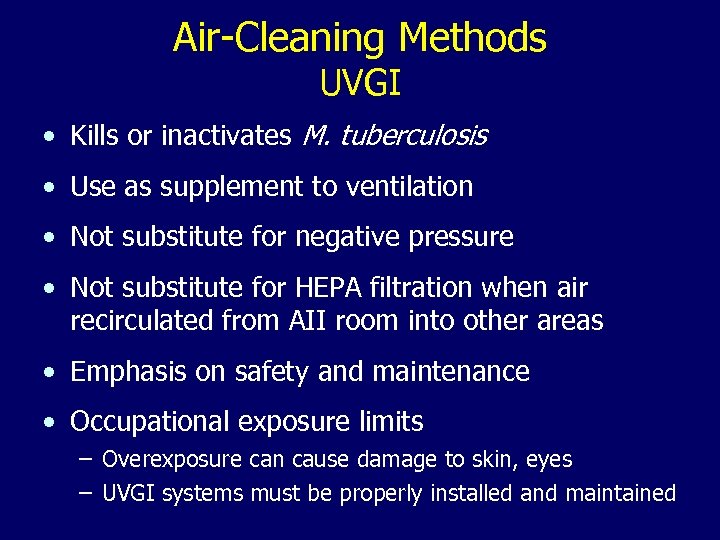
Air-Cleaning Methods UVGI • Kills or inactivates M. tuberculosis • Use as supplement to ventilation • Not substitute for negative pressure • Not substitute for HEPA filtration when air recirculated from AII room into other areas • Emphasis on safety and maintenance • Occupational exposure limits – Overexposure can cause damage to skin, eyes – UVGI systems must be properly installed and maintained

Respiratory Protection General • Third level in the IC hierarchy • Should be used by persons – Entering rooms of suspected/confirmed TB patients – Around cough- or aerosol-producing procedures – In settings where administrative and environmental controls will not prevent the inhalation of infectious droplet nuclei • Decision on use of respiratory protection (RP) in labs should be made on case-by-case basis

Respiratory Protection Program (1) • Settings where HCWs use RP to prevent M. tuberculosis infection should develop, implement, and maintain an RP program; include all HCWs who use RP • Provide HCWs annual training on TB control, IC, and RP • Give HCWs time to become proficient and comfortable with respirators

Respiratory Protection Program (2) • Settings with no AII rooms, no cough- or aerosol-producing procedures, or no expectations of patients with suspected or confirmed TB do not need an RP program – Have written protocols for recognizing signs or symptoms of TB and referring or transferring patients to a setting where they can be managed

Considerations for Selecting Respirators (1) • Minimum respiratory protection is a filtering facepiece respirator (nonpowered, air-purifying, half-facepiece, such as N 95 disposable). • In high-risk situations (cough- or aerosolproducing activities), additional protection may be needed

Considerations for Selecting Respirators (2) • Use respirators that also protect HCWs against mucous membrane exposure to bloodborne pathogens as appropriate • Use respirators without exhalation valve during procedures requiring sterile field • Consider offering respirators (e. g. , N 95 disposable) to visitors to AII rooms
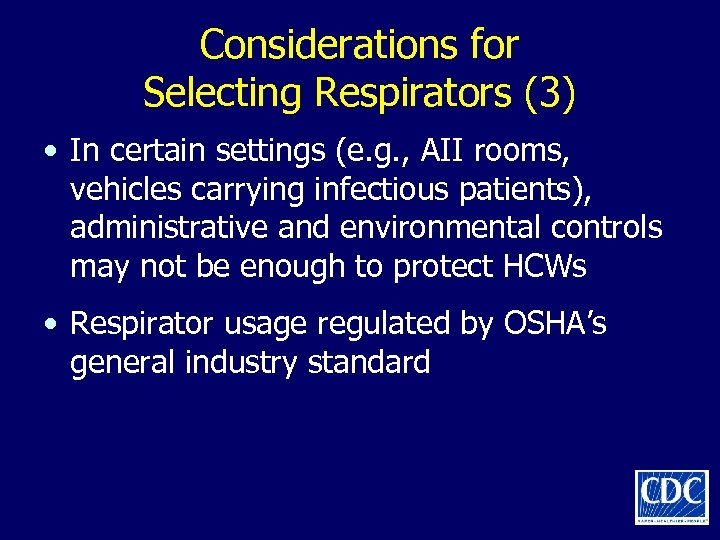
Considerations for Selecting Respirators (3) • In certain settings (e. g. , AII rooms, vehicles carrying infectious patients), administrative and environmental controls may not be enough to protect HCWs • Respirator usage regulated by OSHA’s general industry standard

Respiratory Protection Performance Criteria • The following can be used for protection against M. tuberculosis – Nonpowered particulate filter respirators certified by CDC/NIOSH: N-, R-, or P-95, 99, or 100), including disposable respirators, or powered air-purifying respirators (PAPR) with high-efficiency filters • Respirators should fit different face sizes and features of HCWs
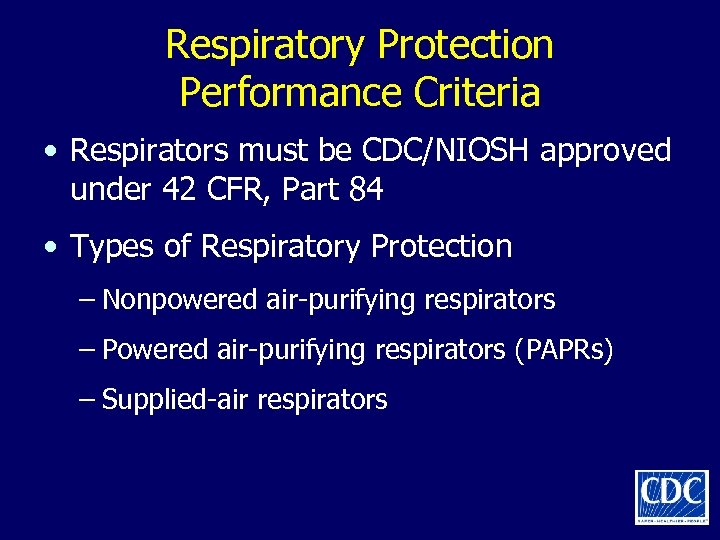
Respiratory Protection Performance Criteria • Respirators must be CDC/NIOSH approved under 42 CFR, Part 84 • Types of Respiratory Protection – Nonpowered air-purifying respirators – Powered air-purifying respirators (PAPRs) – Supplied-air respirators

Nonpowered Air-Purifying Respirators Resistance to Degradation Filter Efficiencies 95 (95%)* 99 (99%)* 100 (99. 97%)* N (not resistant to oil) N 95 N 99 N 100 R (resistant to oil) R 95 R 99 R 100 P (oil proof) P 95 P 99 P 100 * The percentages in parentheses indicate the minimum allowable laboratory filter efficiency value when challenged with 0. 3 μm particles

Effectiveness of Respiratory Protection Devices • Face seal fit determines protective ability • Filter efficiency depends on – Filtration characteristics – Size distribution of droplets in the aerosol – Velocity through the filter – Filter loading – Electrostatic charges on the filter

Implementing a Respiratory Protection Program • Assign responsibility • Train HCWs annually • Conduct fit testing of HCWs – During initial RP program training – Periodically thereafter • Inspect and maintain respirators • Evaluate program periodically

Cough- and Aerosol-Producing Procedures Requiring Use of RP • Cough-producing procedures – Endotracheal intubation, suctioning, diagnostic sputum induction, aerosol treatments, bronchoscopy, laryngoscopy – Gastric aspiration and nasogastric intubation can induce cough in some patients • Aerosol-producing procedures: – Irrigating TB abscesses, homogenizing or lyophilizing tissue, performing autopsies

Estimating Infectiousness of Patients

Characteristics of Infectiousness (1) Infectiousness related to – Cough >3 weeks – Cavitation on chest radiograph – Positive sputum smear results

Characteristics of Infectiousness (2) – Respiratory tract disease involving lung, airway, or larynx – Failure to cover mouth and nose when coughing – Inadequate treatment – Undergoing cough- or aerosol-producing procedures
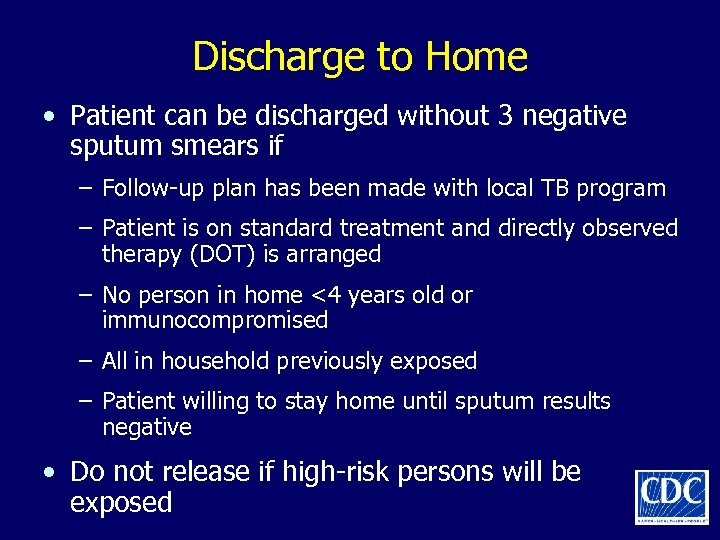
Discharge to Home • Patient can be discharged without 3 negative sputum smears if – Follow-up plan has been made with local TB program – Patient is on standard treatment and directly observed therapy (DOT) is arranged – No person in home <4 years old or immunocompromised – All in household previously exposed – Patient willing to stay home until sputum results negative • Do not release if high-risk persons will be exposed

Drug-Resistant Disease • Consider AII precautions for MDR TB patients until discharge or culture conversion – Transmission from MDR TB patients may be extensive • Risk for transmission not increased in TB/HIV coinfected patients vs. TB patients

Diagnostic Procedures for Latent TB Infection and TB Disease

Diagnosis of Latent TB Infection • Persons with LTBI – Are asymptomatic – Do not feel sick – Cannot spread TB to others • Diagnostic procedures – Positive TST with medical evaluation to exclude TB • Evaluation includes assessing symptoms and signs, xray, and sputum tests – Blood assay for M. tuberculosis (BAMT) now available

Tuberculin Skin Test (1) • TST is most used test for M. tuberculosis infection in U. S. • Improve variable results by HCW training and attention to detail • Improve HCW adherence to serial TST by revising operational policies and HCW training
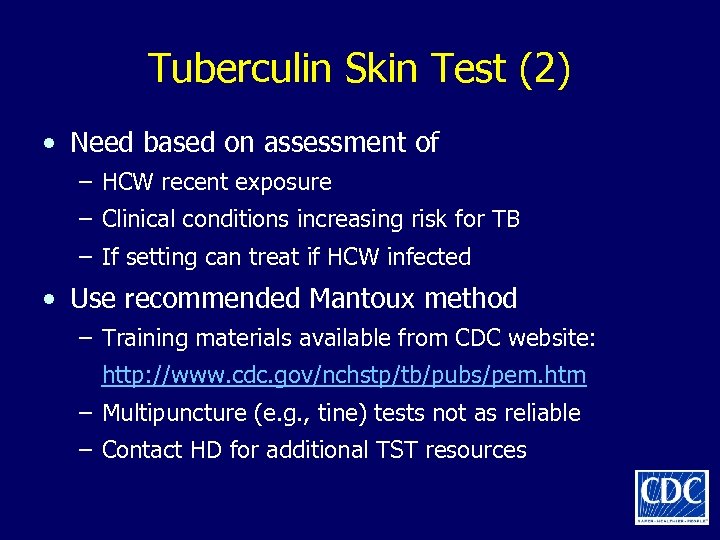
Tuberculin Skin Test (2) • Need based on assessment of – HCW recent exposure – Clinical conditions increasing risk for TB – If setting can treat if HCW infected • Use recommended Mantoux method – Training materials available from CDC website: http: //www. cdc. gov/nchstp/tb/pubs/pem. htm – Multipuncture (e. g. , tine) tests not as reliable – Contact HD for additional TST resources

Administering the TST • Inject 0. 1 m. L PPD intradermally • Should produce wheal of 6– 10 mm • Do not recap, bend, break, remove needles from syringes • Follow standard IC precautions

Reading TST Result • Read 48– 72 hrs after placement – If HCW returns after >72 hrs, place and read another TST* – Do not let HCWs read their own results • Find and measure induration – Measure diameter of induration across the arm – Do not measure redness * If the TST reaction is read as ≥ 15 mm up to 7 days after placement, the result can be considered positive.
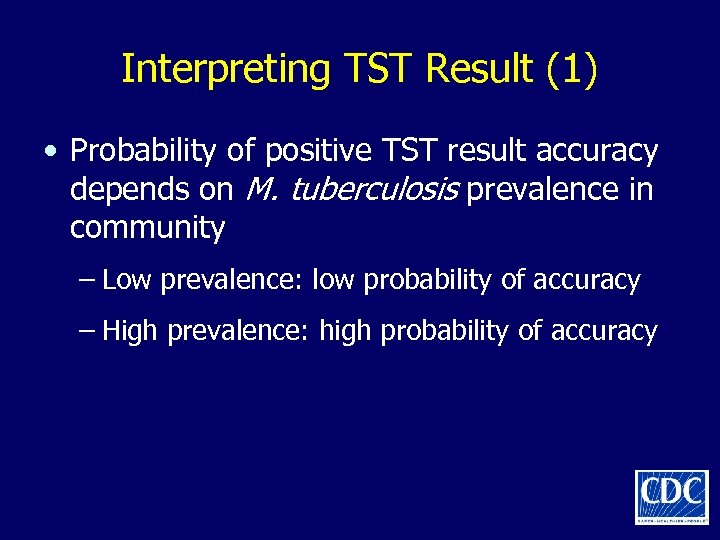
Interpreting TST Result (1) • Probability of positive TST result accuracy depends on M. tuberculosis prevalence in community – Low prevalence: low probability of accuracy – High prevalence: high probability of accuracy
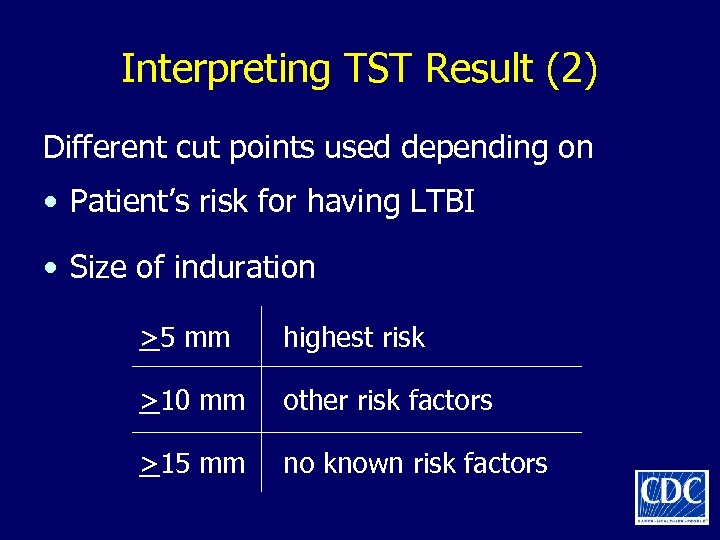
Interpreting TST Result (2) Different cut points used depending on • Patient’s risk for having LTBI • Size of induration >5 mm highest risk >10 mm other risk factors >15 mm no known risk factors

Interpreting TST for HCWs 1. Baseline ≥ 10 mm = positive (≥ 5 if HCW has HIV) 2. Serial testing Increase of ≥ 10 mm = positive (TST conversion) 3. Known exposure ≥ 5 mm = positive when baseline result is 0 mm; increase of ≥ 10 mm = positive when baseline result is negative or previous followup TST result ≥ 0 mm

Special Considerations in TST • Anergy • Antiretroviral therapy for HIV infection • Pregnancy • TST boosting • Use of two-step TST • BCG vaccination • Differences in PPD preparations

Anergy • Anergy is the immune system’s failure to respond to injected reagents or antigens • Persons with compromised immunity may not react to tuberculin • A few persons with normal immunity also do not react • Thus, absence of TST reaction does not rule out LTBI or TB disease • Anergy testing not recommended as adjunct to TST, because TST results alone cannot guide clinical decision making

HIV Patients with Reconstituted Delayed. Type Hypersensitivity (DTH) Response • HIV patients with initial negative TST result can convert to positive after starting highly active antiretroviral therapy (HAART) because of improved immunity • Should repeat testing for M. tuberculosis infection in HIV-infected patients with previous negative M. tuberculosis result after starting HAART

Pregnancy • No change in guidelines • No evidence that TST has any adverse effects on pregnant mother or fetus • Pregnant HCWs should be included in serial skin testing; no contraindications • Postponing diagnosis of M. tuberculosis infection during pregnancy is unacceptable
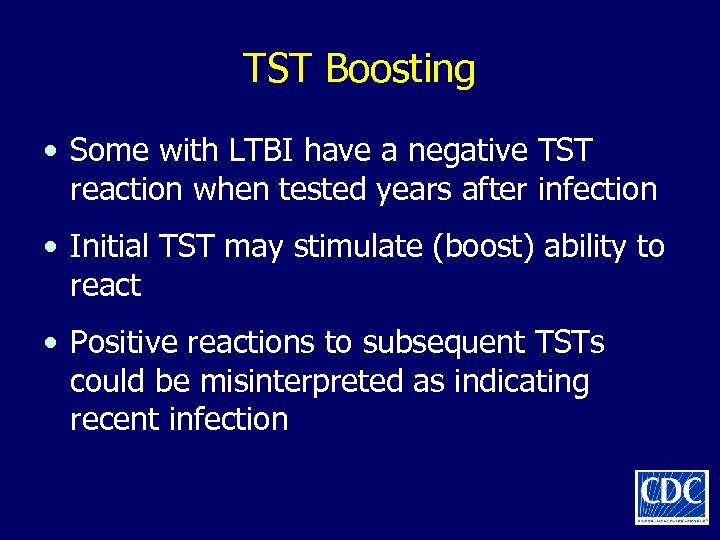
TST Boosting • Some with LTBI have a negative TST reaction when tested years after infection • Initial TST may stimulate (boost) ability to react • Positive reactions to subsequent TSTs could be misinterpreted as indicating recent infection

TST Two-Step Testing Used for initial baseline M. tuberculosis testing for those who will be given TST periodically • No previous TST: do two-step test • First test positive: consider TB infected • First test negative: retest in 1– 3 wks (after first TST result was read) • Second test positive: consider TB infected • Second test negative: consider not infected

BCG Vaccination • Not routinely recommended in U. S. • BCG vaccination not a contraindication to TST • Can lead to boosting in baseline two-step testing – Boosted reaction from previous BCG (false positive) is indistinguishable from M. tuberculosis reaction (true positive)

Differences in PPD Preparations (1) • Two PPD preparations available in U. S. – APLISOL ® – Tubersol® • Compared to U. S. standard, no differences* * Villarino ME, Burman W, Wang YC, Lundergan L, Catanzaro A, Bock N, Jones C, Nolan C. Comparable specificity of 2 commercial tuberculin reagents in persons at low risk for tuberculosis infection. JAMA 1999: 281(2): 169 -71.

Differences in PPD Preparations (2) • Compared to each other, APLISOL produces larger reactions ® • Although difference is slight, might affect positivity rate in large institutional settings • Recommend using one product consistently

Use of BAMT Surveillance and LTBI Testing • LTBI traditionally diagnosed with TST • Blood assay for M. tuberculosis (BAMT) available: QFT-Gold • QFT-G was approved by FDA in 2005 and can be used to detect LTBI – Measures interferon (IFN)-gamma released in blood when incubated overnight with various reagents, including antigens specific for M. tuberculosis – Lymphocytes from persons with LTBI react to these proteins by releasing IFN-gamma

Use of BAMT Benefits of QFT-Gold over TST • Requires only one patient visit • Assesses responsiveness to M. tuberculosis antigens • Does not boost previous responses • Interpretation less subjective than for TST • Probably less affected by BCG vaccination

Use of BAMT Baseline and Serial Testing • Baseline testing with BAMT – Establish baseline with single negative BAMT result – HCWs with positive BAMT result should be referred for medical and diagnostic evaluation • Serial testing for infection control – A conversion is a change from negative to positive

Special Considerations • QFT-Gold has not been evaluated in persons aged <17 or pregnant women • The BAMT is not affected by the booster phenomenon as is the TST • BCG vaccination is not a contraindication to having a BAMT and does not influence BAMT results
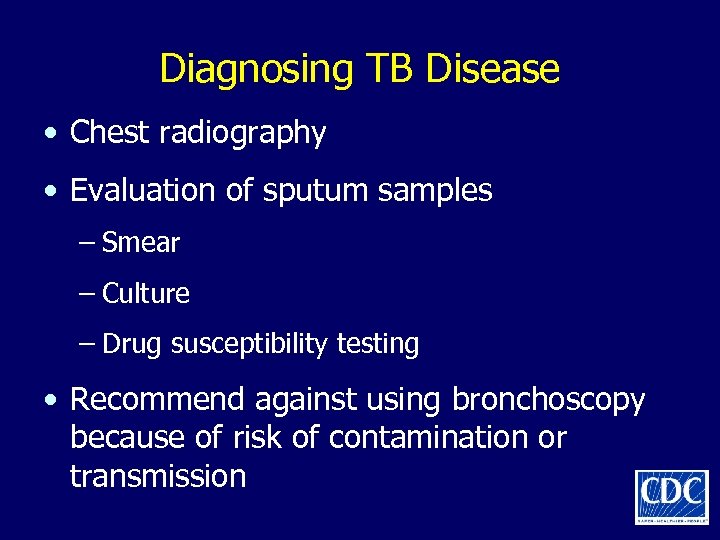
Diagnosing TB Disease • Chest radiography • Evaluation of sputum samples – Smear – Culture – Drug susceptibility testing • Recommend against using bronchoscopy because of risk of contamination or transmission

Treatment Procedures for LTBI and TB Disease

Treatment for LTBI • Treating LTBI reduces the risk that M. tuberculosis infection will develop into TB disease • Certain groups have higher risk for developing TB disease after infection; should be treated • Before beginning treatment for LTBI – Exclude diagnosis of TB – Ensure patient has no history of adverse reactions resulting from prior LTBI treatment

Candidates for Treatment for LTBI Give LTBI Treatment to Highest risk groups If M. tuberculosis Test Result Is ≥ 5 mm • Immunocompromised • Recent contacts • X-ray indicates previous TB Other high-risk groups ≥ 10 mm Patients with no risks ≥ 15 mm The frequency of TB testing for HCWs will be determined by the risk classification for the setting.

Treatment Regiments for LTBI Drugs INH Months of Duration 9* INH 6 RIF 4 *Preferred INH=isoniazid; RIF=rifampin Interval Minimum Doses Daily 270 2 x wkly 76 Daily 180 2 x wkly 52 Daily 120

Treatment for TB Disease (1) • TB treatment regimens must contain multiple drugs to which M. tuberculosis is susceptible • Treating TB disease with a single drug can lead to resistance • Also, adding a single drug to a failing regimen can lead to drug resistance

Treatment for TB Disease (2) • Preferred regimen – Initial phase: 2 months isoniazid (INH), rifampin (RIF), pyrazinamide (PZA), and ethambutol – Continuation phase: 4 months INH and RIF • In patients with cavitary pulmonary TB and positive culture results at end of initiation phase, continuation phase should be 7 months • TB patients with HIV who are taking antiretrovirals (ARVs) should be managed by TB/HIV disease experts – TB treatment regimens might need to be altered

Cleaning, Disinfecting, and Sterilizing Patient Rooms (1) • Three categories of medical equipment: critical, semicritical, and noncritical • Critical: Instruments introduced directly into bloodstream or other normally sterile areas (e. g. , needles, surgical instruments) should be sterile at time of use

Cleaning, Disinfecting, and Sterilizing Patient Rooms (2) • Semicritical: Do not penetrate body surfaces but might come into contact with mucous membranes; clean with high-level disinfectant • Noncritical: Do not touch patient, or only touch skin; not associated with transmission

References • Centers for Disease Control and Prevention. Guidelines for preventing the transmission of Mycobacterium tuberculosis in health-care settings, 2005. MMWR 2005; 54 (No. RR-17): 1– 141. http: //www. cdc. gov/nchstp/tb/pubs/mmwrhtml/ Maj_guide/infectioncontrol. htm • Errata (August 2006) available online http: //www. cdc. gov/nchstp/tb/pubs/mmwrhtml/ Errata_table. pdf

Continuing Education Credits (1) • Continuing education credits will be available until December 30, 2008 • Participants will receive one of the following: – 3. 5 hours continuing medical education (CME) credit – 0. 35 continuing education units (CEUs) – 4. 0 contact hours continuing nursing education (CNE) credit – 3. 5 contact hours National Commission for Health Education Credentialing (NCHEC) credit • Participants are required to read and study the guidelines, take a test, and complete an evaluation

Continuing Education Credits (2) • If you return the form electronically, you will receive educational credit immediately. • If you mail the form, you will receive educational credit in approximately 30 days. • No fees are charged for participating in this continuing education activity. • MMWR CE Credit: http: //www. cdc/gov/mmwr/cme/conted. html

Additional Resources For additional information on TB, visit the CDC Division of Tuberculosis Elimination website at http: //www. cdc. gov/tb

Additional TB Guidelines • CDC. Prevention and Control of Tuberculosis in Correctional and Detention Facilities: Recommendations from CDC. MMWR 2006; 55 (No. RR-09): 1– 44. • CDC. Guidelines for the investigation of contacts of persons with infectious tuberculosis: recommendations from the National Tuberculosis Controllers Association and CDC. MMWR 2005; 54 (No. RR-15): 1 -37. • CDC. Guidelines for using the Quanti. FERON-TB Gold Test for detecting Mycobacterium tuberculosis infection, United States. MMWR 2005; 54 (No. RR -15): 49 -55. • CDC. Controlling tuberculosis in the United States: recommendations from the American Thoracic Society, CDC, and the Infectious Diseases Society of America. MMWR 2005; 54 (No. RR-12): 1 -81. • CDC. Guidelines for infection control in dental health-care settings— 2003. MMWR 2003; 52 (No. RR-17). • CDC. Treatment of tuberculosis. American Thoracic Society, CDC, and Infectious Diseases Society of America. MMWR 2003; 52 (No. RR-11). • CDC. Guidelines for environmental infection control in health-care facilities: recommendations of CDC and the Healthcare Infection Control Practices Advisory Committee (HICPAC). MMWR 2003; 52 (No. RR-10).
c7641a30be4af2cd7a6f0115b15f619b.ppt